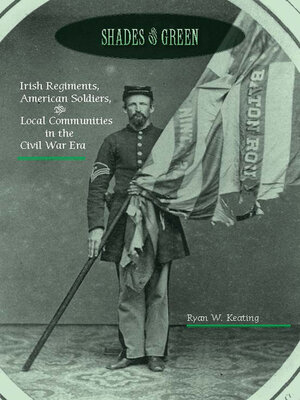Shades of Green
ebook ∣ Irish Regiments, American Soldiers, & Local Communities in the Civil War Era · The North's Civil War
By Ryan W. Keating

Sign up to save your library
With an OverDrive account, you can save your favorite libraries for at-a-glance information about availability. Find out more about OverDrive accounts.
Find this title in Libby, the library reading app by OverDrive.



Search for a digital library with this title
Title found at these libraries:
| Loading... |
“An exceptional book that should make an immediately positive impact on the study of Irish Americans in the Civil War.” —The Journal of Southern History
Drawing on records of about 5,500 soldiers and veterans, Shades of Green traces the organization of Irish regiments from the perspective of local communities in Connecticut, Illinois, and Wisconsin and the relationships between soldiers and the home front. Research on the impact of the Civil War on Irish Americans has traditionally fallen into one of two tracks, arguing that the Civil War either further alienated Irish immigrants from American society or that military service in defense of the Union offered these men a means of assimilation. In this study of Irish American service, Ryan W. Keating argues that neither paradigm really holds, because many Irish Americans during this time already considered themselves to be assimilated members of American society.
This comprehensive study argues that the local community was often more important to ethnic soldiers than the imagined ethnic community, especially in terms of political, social, and economic relationships. An analysis of the Civil War era from this perspective provides a much clearer understanding of immigrant place and identity during the nineteenth century.
The author focuses on three regiments not traditionally studied—rather than those of New York City and Boston—and supports his argument through advanced quantitative analysis of military service records and a wealth of raw data, an unusual and exciting development in Civil War studies. Shades of Green’s impressive research provides a significant contribution to scholarship sure to bring something valuable to several fields of study.
Drawing on records of about 5,500 soldiers and veterans, Shades of Green traces the organization of Irish regiments from the perspective of local communities in Connecticut, Illinois, and Wisconsin and the relationships between soldiers and the home front. Research on the impact of the Civil War on Irish Americans has traditionally fallen into one of two tracks, arguing that the Civil War either further alienated Irish immigrants from American society or that military service in defense of the Union offered these men a means of assimilation. In this study of Irish American service, Ryan W. Keating argues that neither paradigm really holds, because many Irish Americans during this time already considered themselves to be assimilated members of American society.
This comprehensive study argues that the local community was often more important to ethnic soldiers than the imagined ethnic community, especially in terms of political, social, and economic relationships. An analysis of the Civil War era from this perspective provides a much clearer understanding of immigrant place and identity during the nineteenth century.
The author focuses on three regiments not traditionally studied—rather than those of New York City and Boston—and supports his argument through advanced quantitative analysis of military service records and a wealth of raw data, an unusual and exciting development in Civil War studies. Shades of Green’s impressive research provides a significant contribution to scholarship sure to bring something valuable to several fields of study.






